Examining Ethics and Sustainability in Business: Case Studies
VerifiedAdded on 2023/06/03
|9
|2472
|66
Essay
AI Summary
This essay delves into the critical importance of ethics and sustainability in contemporary business, highlighting the ethical dilemmas organizations face, such as security breaches and data theft. It analyzes business ethics as the practice of making ethical decisions and acting with integrity, emphasizing that written codes of conduct are not always sufficient and that formal training is crucial. The essay also addresses sustainability as a key consideration for companies, focusing on the environmental, social, and economic impacts of business operations. Through case studies, including Anderson Office Supplies and Global Batteries Corporation, the essay illustrates the consequences of unethical behavior and unsustainable practices. It concludes by underscoring the necessity for leaders to prioritize ethical and sustainable considerations in their decision-making processes to drive organizational success and responsibility. Desklib provides access to this essay along with a wide range of study resources.

Running head: ETHICS AND SUSTAINANBILITY IN BUSINESS
ETHICS AND SUSTAINANBILITY IN BUSINESS
Name of the student:
Name of the university:
Author note:
ETHICS AND SUSTAINANBILITY IN BUSINESS
Name of the student:
Name of the university:
Author note:
Paraphrase This Document
Need a fresh take? Get an instant paraphrase of this document with our AI Paraphraser
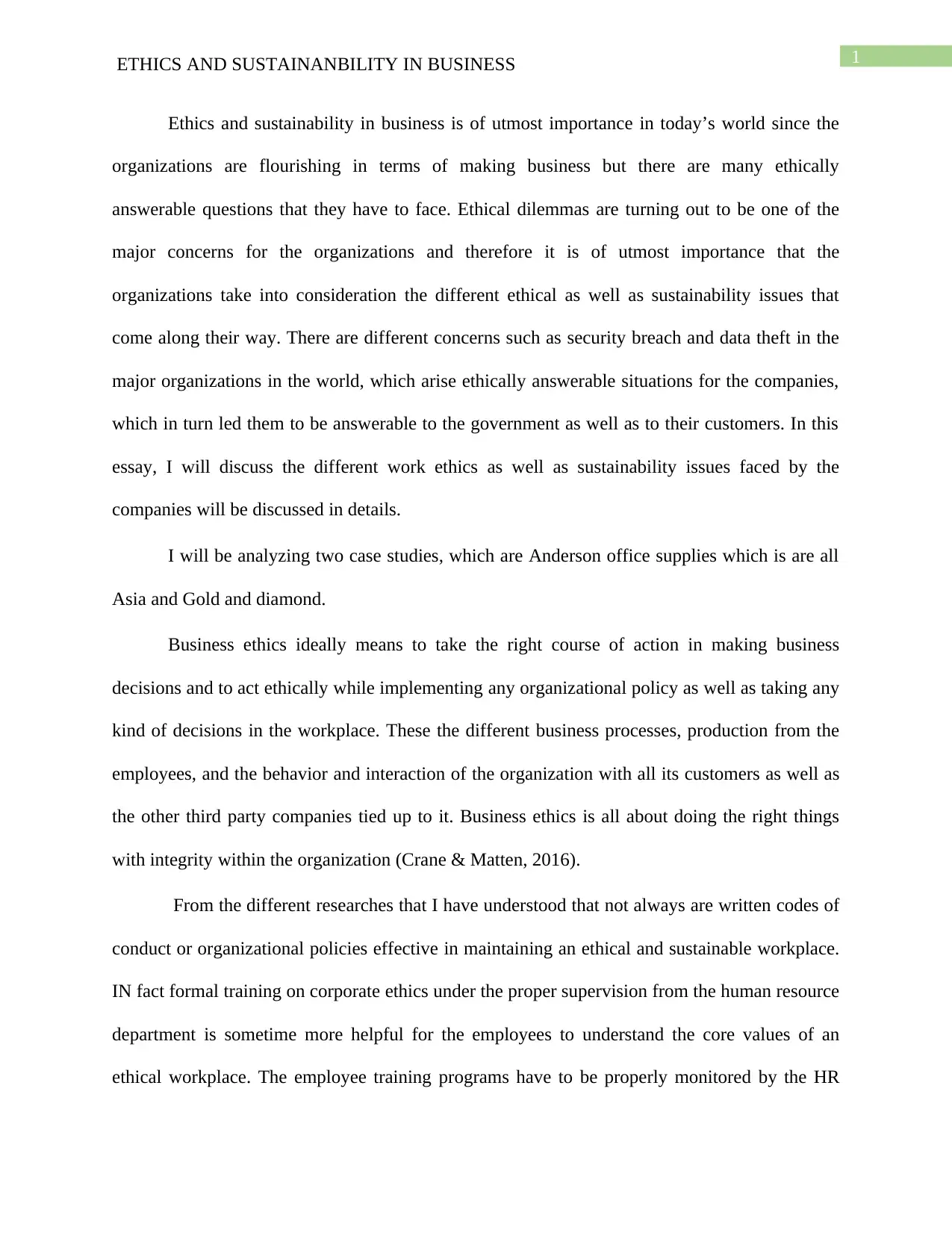
1ETHICS AND SUSTAINANBILITY IN BUSINESS
Ethics and sustainability in business is of utmost importance in today’s world since the
organizations are flourishing in terms of making business but there are many ethically
answerable questions that they have to face. Ethical dilemmas are turning out to be one of the
major concerns for the organizations and therefore it is of utmost importance that the
organizations take into consideration the different ethical as well as sustainability issues that
come along their way. There are different concerns such as security breach and data theft in the
major organizations in the world, which arise ethically answerable situations for the companies,
which in turn led them to be answerable to the government as well as to their customers. In this
essay, I will discuss the different work ethics as well as sustainability issues faced by the
companies will be discussed in details.
I will be analyzing two case studies, which are Anderson office supplies which is are all
Asia and Gold and diamond.
Business ethics ideally means to take the right course of action in making business
decisions and to act ethically while implementing any organizational policy as well as taking any
kind of decisions in the workplace. These the different business processes, production from the
employees, and the behavior and interaction of the organization with all its customers as well as
the other third party companies tied up to it. Business ethics is all about doing the right things
with integrity within the organization (Crane & Matten, 2016).
From the different researches that I have understood that not always are written codes of
conduct or organizational policies effective in maintaining an ethical and sustainable workplace.
IN fact formal training on corporate ethics under the proper supervision from the human resource
department is sometime more helpful for the employees to understand the core values of an
ethical workplace. The employee training programs have to be properly monitored by the HR
Ethics and sustainability in business is of utmost importance in today’s world since the
organizations are flourishing in terms of making business but there are many ethically
answerable questions that they have to face. Ethical dilemmas are turning out to be one of the
major concerns for the organizations and therefore it is of utmost importance that the
organizations take into consideration the different ethical as well as sustainability issues that
come along their way. There are different concerns such as security breach and data theft in the
major organizations in the world, which arise ethically answerable situations for the companies,
which in turn led them to be answerable to the government as well as to their customers. In this
essay, I will discuss the different work ethics as well as sustainability issues faced by the
companies will be discussed in details.
I will be analyzing two case studies, which are Anderson office supplies which is are all
Asia and Gold and diamond.
Business ethics ideally means to take the right course of action in making business
decisions and to act ethically while implementing any organizational policy as well as taking any
kind of decisions in the workplace. These the different business processes, production from the
employees, and the behavior and interaction of the organization with all its customers as well as
the other third party companies tied up to it. Business ethics is all about doing the right things
with integrity within the organization (Crane & Matten, 2016).
From the different researches that I have understood that not always are written codes of
conduct or organizational policies effective in maintaining an ethical and sustainable workplace.
IN fact formal training on corporate ethics under the proper supervision from the human resource
department is sometime more helpful for the employees to understand the core values of an
ethical workplace. The employee training programs have to be properly monitored by the HR
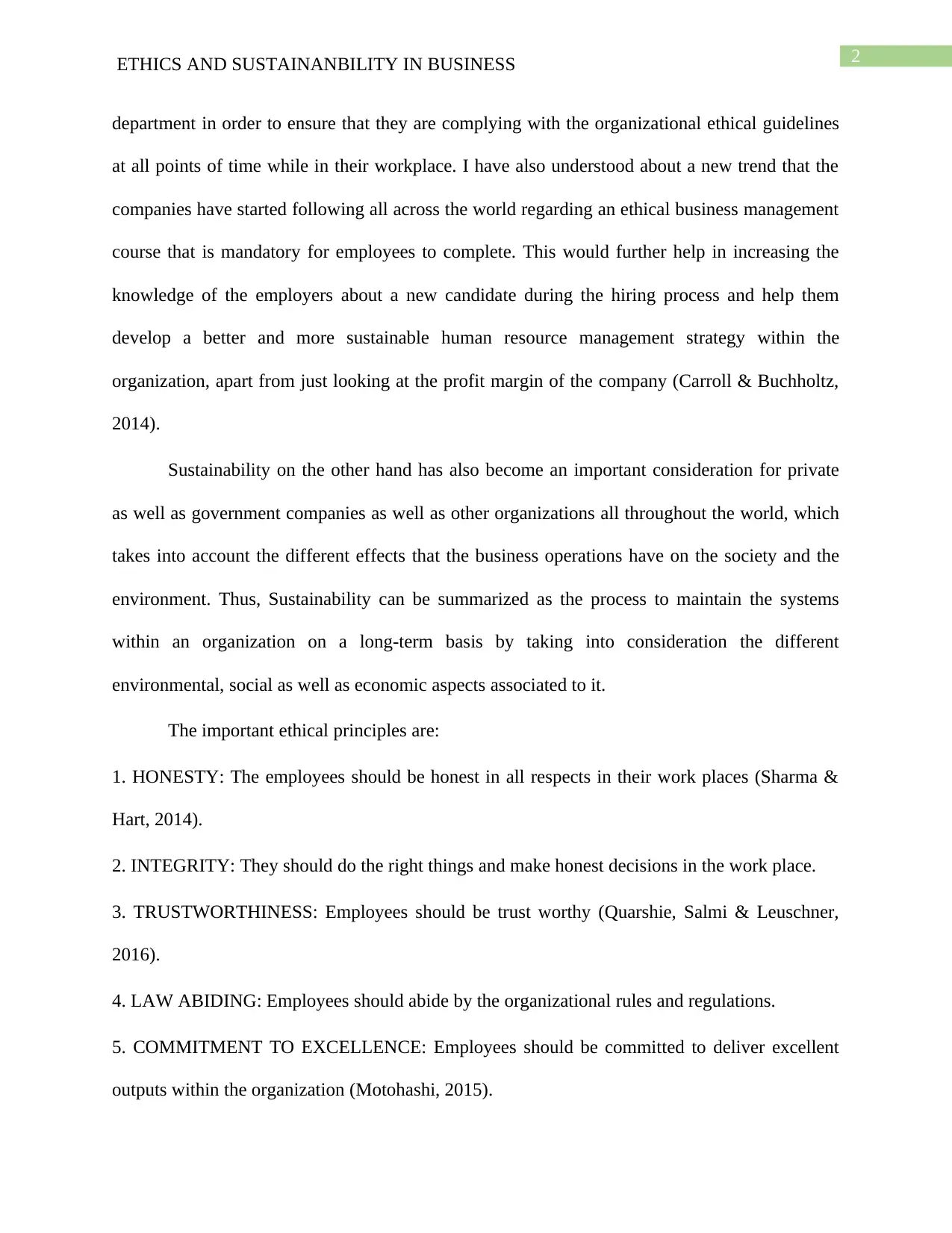
2ETHICS AND SUSTAINANBILITY IN BUSINESS
department in order to ensure that they are complying with the organizational ethical guidelines
at all points of time while in their workplace. I have also understood about a new trend that the
companies have started following all across the world regarding an ethical business management
course that is mandatory for employees to complete. This would further help in increasing the
knowledge of the employers about a new candidate during the hiring process and help them
develop a better and more sustainable human resource management strategy within the
organization, apart from just looking at the profit margin of the company (Carroll & Buchholtz,
2014).
Sustainability on the other hand has also become an important consideration for private
as well as government companies as well as other organizations all throughout the world, which
takes into account the different effects that the business operations have on the society and the
environment. Thus, Sustainability can be summarized as the process to maintain the systems
within an organization on a long-term basis by taking into consideration the different
environmental, social as well as economic aspects associated to it.
The important ethical principles are:
1. HONESTY: The employees should be honest in all respects in their work places (Sharma &
Hart, 2014).
2. INTEGRITY: They should do the right things and make honest decisions in the work place.
3. TRUSTWORTHINESS: Employees should be trust worthy (Quarshie, Salmi & Leuschner,
2016).
4. LAW ABIDING: Employees should abide by the organizational rules and regulations.
5. COMMITMENT TO EXCELLENCE: Employees should be committed to deliver excellent
outputs within the organization (Motohashi, 2015).
department in order to ensure that they are complying with the organizational ethical guidelines
at all points of time while in their workplace. I have also understood about a new trend that the
companies have started following all across the world regarding an ethical business management
course that is mandatory for employees to complete. This would further help in increasing the
knowledge of the employers about a new candidate during the hiring process and help them
develop a better and more sustainable human resource management strategy within the
organization, apart from just looking at the profit margin of the company (Carroll & Buchholtz,
2014).
Sustainability on the other hand has also become an important consideration for private
as well as government companies as well as other organizations all throughout the world, which
takes into account the different effects that the business operations have on the society and the
environment. Thus, Sustainability can be summarized as the process to maintain the systems
within an organization on a long-term basis by taking into consideration the different
environmental, social as well as economic aspects associated to it.
The important ethical principles are:
1. HONESTY: The employees should be honest in all respects in their work places (Sharma &
Hart, 2014).
2. INTEGRITY: They should do the right things and make honest decisions in the work place.
3. TRUSTWORTHINESS: Employees should be trust worthy (Quarshie, Salmi & Leuschner,
2016).
4. LAW ABIDING: Employees should abide by the organizational rules and regulations.
5. COMMITMENT TO EXCELLENCE: Employees should be committed to deliver excellent
outputs within the organization (Motohashi, 2015).
⊘ This is a preview!⊘
Do you want full access?
Subscribe today to unlock all pages.

Trusted by 1+ million students worldwide
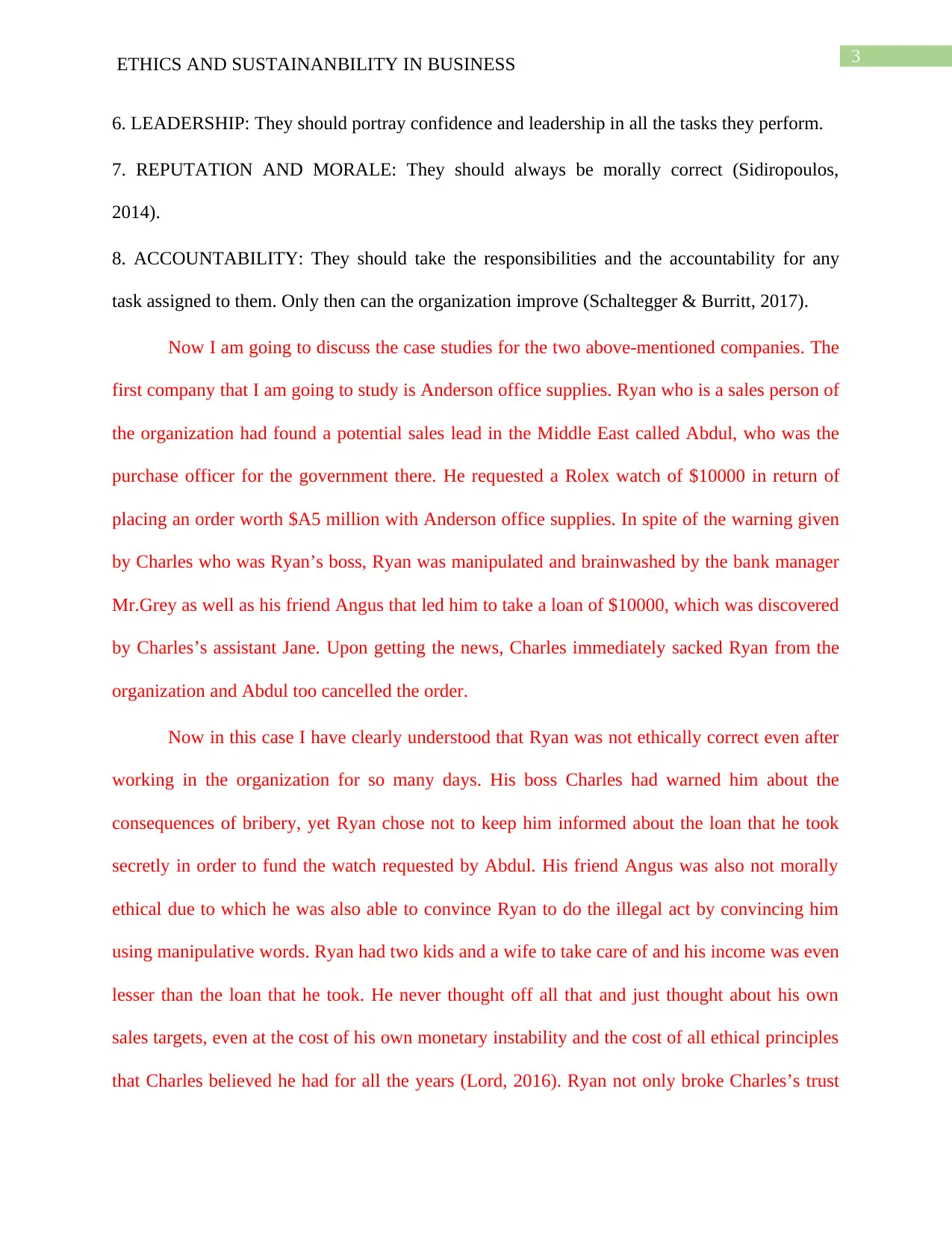
3ETHICS AND SUSTAINANBILITY IN BUSINESS
6. LEADERSHIP: They should portray confidence and leadership in all the tasks they perform.
7. REPUTATION AND MORALE: They should always be morally correct (Sidiropoulos,
2014).
8. ACCOUNTABILITY: They should take the responsibilities and the accountability for any
task assigned to them. Only then can the organization improve (Schaltegger & Burritt, 2017).
Now I am going to discuss the case studies for the two above-mentioned companies. The
first company that I am going to study is Anderson office supplies. Ryan who is a sales person of
the organization had found a potential sales lead in the Middle East called Abdul, who was the
purchase officer for the government there. He requested a Rolex watch of $10000 in return of
placing an order worth $A5 million with Anderson office supplies. In spite of the warning given
by Charles who was Ryan’s boss, Ryan was manipulated and brainwashed by the bank manager
Mr.Grey as well as his friend Angus that led him to take a loan of $10000, which was discovered
by Charles’s assistant Jane. Upon getting the news, Charles immediately sacked Ryan from the
organization and Abdul too cancelled the order.
Now in this case I have clearly understood that Ryan was not ethically correct even after
working in the organization for so many days. His boss Charles had warned him about the
consequences of bribery, yet Ryan chose not to keep him informed about the loan that he took
secretly in order to fund the watch requested by Abdul. His friend Angus was also not morally
ethical due to which he was also able to convince Ryan to do the illegal act by convincing him
using manipulative words. Ryan had two kids and a wife to take care of and his income was even
lesser than the loan that he took. He never thought off all that and just thought about his own
sales targets, even at the cost of his own monetary instability and the cost of all ethical principles
that Charles believed he had for all the years (Lord, 2016). Ryan not only broke Charles’s trust
6. LEADERSHIP: They should portray confidence and leadership in all the tasks they perform.
7. REPUTATION AND MORALE: They should always be morally correct (Sidiropoulos,
2014).
8. ACCOUNTABILITY: They should take the responsibilities and the accountability for any
task assigned to them. Only then can the organization improve (Schaltegger & Burritt, 2017).
Now I am going to discuss the case studies for the two above-mentioned companies. The
first company that I am going to study is Anderson office supplies. Ryan who is a sales person of
the organization had found a potential sales lead in the Middle East called Abdul, who was the
purchase officer for the government there. He requested a Rolex watch of $10000 in return of
placing an order worth $A5 million with Anderson office supplies. In spite of the warning given
by Charles who was Ryan’s boss, Ryan was manipulated and brainwashed by the bank manager
Mr.Grey as well as his friend Angus that led him to take a loan of $10000, which was discovered
by Charles’s assistant Jane. Upon getting the news, Charles immediately sacked Ryan from the
organization and Abdul too cancelled the order.
Now in this case I have clearly understood that Ryan was not ethically correct even after
working in the organization for so many days. His boss Charles had warned him about the
consequences of bribery, yet Ryan chose not to keep him informed about the loan that he took
secretly in order to fund the watch requested by Abdul. His friend Angus was also not morally
ethical due to which he was also able to convince Ryan to do the illegal act by convincing him
using manipulative words. Ryan had two kids and a wife to take care of and his income was even
lesser than the loan that he took. He never thought off all that and just thought about his own
sales targets, even at the cost of his own monetary instability and the cost of all ethical principles
that Charles believed he had for all the years (Lord, 2016). Ryan not only broke Charles’s trust
Paraphrase This Document
Need a fresh take? Get an instant paraphrase of this document with our AI Paraphraser
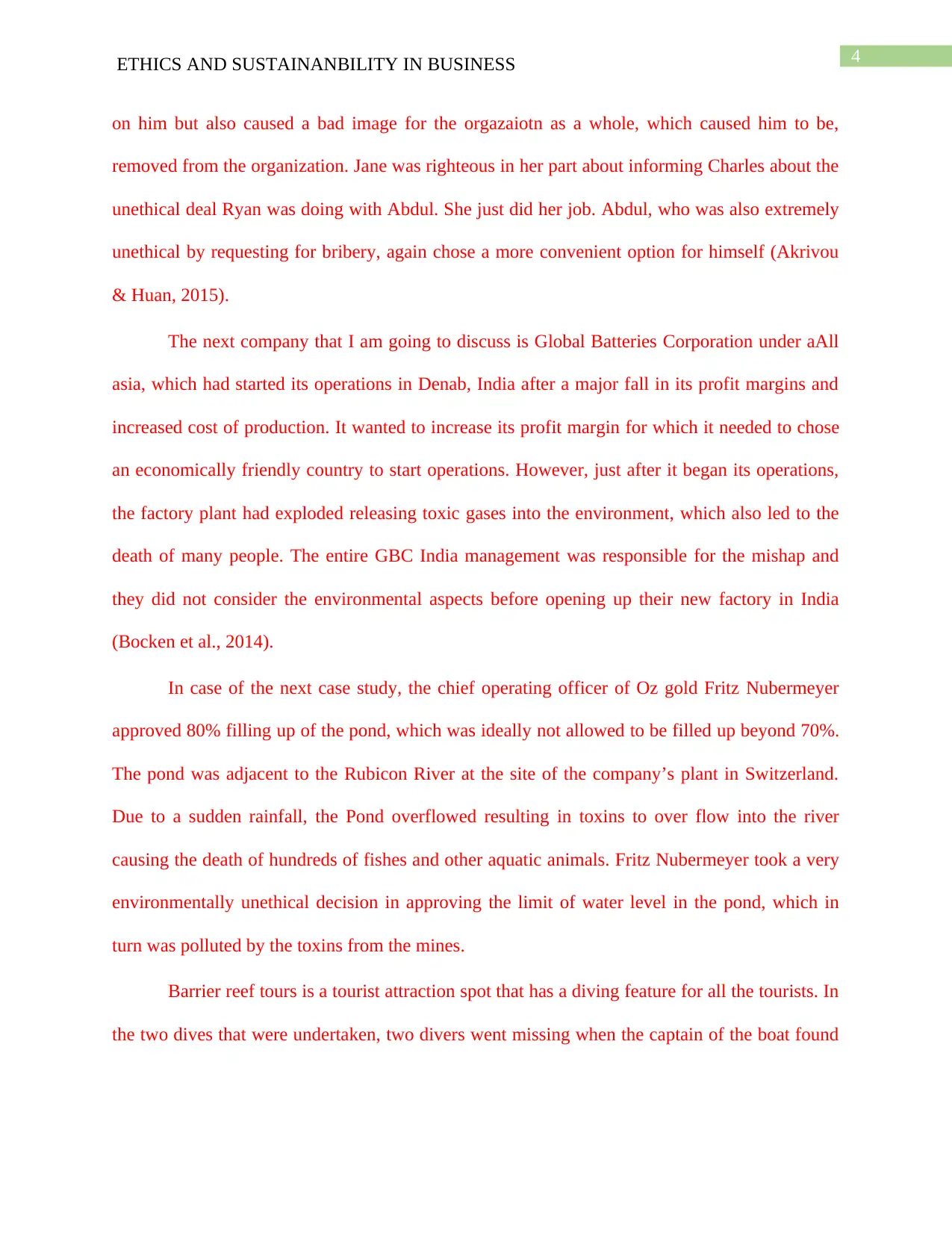
4ETHICS AND SUSTAINANBILITY IN BUSINESS
on him but also caused a bad image for the orgazaiotn as a whole, which caused him to be,
removed from the organization. Jane was righteous in her part about informing Charles about the
unethical deal Ryan was doing with Abdul. She just did her job. Abdul, who was also extremely
unethical by requesting for bribery, again chose a more convenient option for himself (Akrivou
& Huan, 2015).
The next company that I am going to discuss is Global Batteries Corporation under aAll
asia, which had started its operations in Denab, India after a major fall in its profit margins and
increased cost of production. It wanted to increase its profit margin for which it needed to chose
an economically friendly country to start operations. However, just after it began its operations,
the factory plant had exploded releasing toxic gases into the environment, which also led to the
death of many people. The entire GBC India management was responsible for the mishap and
they did not consider the environmental aspects before opening up their new factory in India
(Bocken et al., 2014).
In case of the next case study, the chief operating officer of Oz gold Fritz Nubermeyer
approved 80% filling up of the pond, which was ideally not allowed to be filled up beyond 70%.
The pond was adjacent to the Rubicon River at the site of the company’s plant in Switzerland.
Due to a sudden rainfall, the Pond overflowed resulting in toxins to over flow into the river
causing the death of hundreds of fishes and other aquatic animals. Fritz Nubermeyer took a very
environmentally unethical decision in approving the limit of water level in the pond, which in
turn was polluted by the toxins from the mines.
Barrier reef tours is a tourist attraction spot that has a diving feature for all the tourists. In
the two dives that were undertaken, two divers went missing when the captain of the boat found
on him but also caused a bad image for the orgazaiotn as a whole, which caused him to be,
removed from the organization. Jane was righteous in her part about informing Charles about the
unethical deal Ryan was doing with Abdul. She just did her job. Abdul, who was also extremely
unethical by requesting for bribery, again chose a more convenient option for himself (Akrivou
& Huan, 2015).
The next company that I am going to discuss is Global Batteries Corporation under aAll
asia, which had started its operations in Denab, India after a major fall in its profit margins and
increased cost of production. It wanted to increase its profit margin for which it needed to chose
an economically friendly country to start operations. However, just after it began its operations,
the factory plant had exploded releasing toxic gases into the environment, which also led to the
death of many people. The entire GBC India management was responsible for the mishap and
they did not consider the environmental aspects before opening up their new factory in India
(Bocken et al., 2014).
In case of the next case study, the chief operating officer of Oz gold Fritz Nubermeyer
approved 80% filling up of the pond, which was ideally not allowed to be filled up beyond 70%.
The pond was adjacent to the Rubicon River at the site of the company’s plant in Switzerland.
Due to a sudden rainfall, the Pond overflowed resulting in toxins to over flow into the river
causing the death of hundreds of fishes and other aquatic animals. Fritz Nubermeyer took a very
environmentally unethical decision in approving the limit of water level in the pond, which in
turn was polluted by the toxins from the mines.
Barrier reef tours is a tourist attraction spot that has a diving feature for all the tourists. In
the two dives that were undertaken, two divers went missing when the captain of the boat found

5ETHICS AND SUSTAINANBILITY IN BUSINESS
two towels and bags on the next morning in the boat. The company is responsible for such a
careless attitude of the dive masters as well as the captains for the loss of the two people.
Another case was for the warmer weather. Bruno Fucco who was the chairperson of the
fire management committee approved 15 controlled burn offs with an objective to prevent
natural bush fires in the summer in the fire prone areas. Immediately on setting the bushes to fire,
the wind aggregated and expanded the fire resulting in far more uncontrollable burn offs. No one
was to be blamed for this incidence since this was caused by nature and primarily they should
now look forward to reducing the fire.
In this section I will discuss the tools used, from which it can be said that Charles did not
even listen to the opinion or explanation of Ryan. The truth for Ryan was not something as
understood and interpreted by Charles. Perhaps Charles was honest in his own way, which
Charles did not even try to understand. In that sense, it can be derived that Charles had very less
theoretical value (Kastalli & Looy, 2013).
Global Batteries Corporation had no economical values, since it never thought about the
negative environmental impacts that its new factory in India can have. More importantly, it did
not give any compensation to the families of the dead resulting from the explosion. They were
just concerned about their profit margins, even if it came from unethical means (Franks et al.,
2014).
Ryan had very less aesthetic values since he did not care even a bit about the beautiful
relationship he shared with his old boss Charles for years at the time of doing the illegal act, who
actually cared for Ryan and loved him. Even Angus had no concerns for his friend and misled
him to make the wrong decision (Welford, 2016).
two towels and bags on the next morning in the boat. The company is responsible for such a
careless attitude of the dive masters as well as the captains for the loss of the two people.
Another case was for the warmer weather. Bruno Fucco who was the chairperson of the
fire management committee approved 15 controlled burn offs with an objective to prevent
natural bush fires in the summer in the fire prone areas. Immediately on setting the bushes to fire,
the wind aggregated and expanded the fire resulting in far more uncontrollable burn offs. No one
was to be blamed for this incidence since this was caused by nature and primarily they should
now look forward to reducing the fire.
In this section I will discuss the tools used, from which it can be said that Charles did not
even listen to the opinion or explanation of Ryan. The truth for Ryan was not something as
understood and interpreted by Charles. Perhaps Charles was honest in his own way, which
Charles did not even try to understand. In that sense, it can be derived that Charles had very less
theoretical value (Kastalli & Looy, 2013).
Global Batteries Corporation had no economical values, since it never thought about the
negative environmental impacts that its new factory in India can have. More importantly, it did
not give any compensation to the families of the dead resulting from the explosion. They were
just concerned about their profit margins, even if it came from unethical means (Franks et al.,
2014).
Ryan had very less aesthetic values since he did not care even a bit about the beautiful
relationship he shared with his old boss Charles for years at the time of doing the illegal act, who
actually cared for Ryan and loved him. Even Angus had no concerns for his friend and misled
him to make the wrong decision (Welford, 2016).
⊘ This is a preview!⊘
Do you want full access?
Subscribe today to unlock all pages.

Trusted by 1+ million students worldwide

6ETHICS AND SUSTAINANBILITY IN BUSINESS
GBC had no social values, which can be seen from the negative impacts its factor
explosion have had on the society.
Lastly, I have clearly understood that Abdul had no political values even though he was a
government employee himself. He had no honesty and integrity that is expected from a
government employee, which led him to ask for such a bribe even after knowing the political
consequences he might, had to face in his work place. Charles had a lot of aesthetic value. He
even loved and cared for Ryan enough to address him by calling “son” (Lindahl, Sundin &
Sakao, 2014).
Therefore, I want to conclude by saying that there are different ethical as well as
sustainable aspects within the organizations that should be considered by the leaders before
taking any kind of business decisions. If these decisions and policies are properly implemented it
can take the organizations to newer heights.
GBC had no social values, which can be seen from the negative impacts its factor
explosion have had on the society.
Lastly, I have clearly understood that Abdul had no political values even though he was a
government employee himself. He had no honesty and integrity that is expected from a
government employee, which led him to ask for such a bribe even after knowing the political
consequences he might, had to face in his work place. Charles had a lot of aesthetic value. He
even loved and cared for Ryan enough to address him by calling “son” (Lindahl, Sundin &
Sakao, 2014).
Therefore, I want to conclude by saying that there are different ethical as well as
sustainable aspects within the organizations that should be considered by the leaders before
taking any kind of business decisions. If these decisions and policies are properly implemented it
can take the organizations to newer heights.
Paraphrase This Document
Need a fresh take? Get an instant paraphrase of this document with our AI Paraphraser
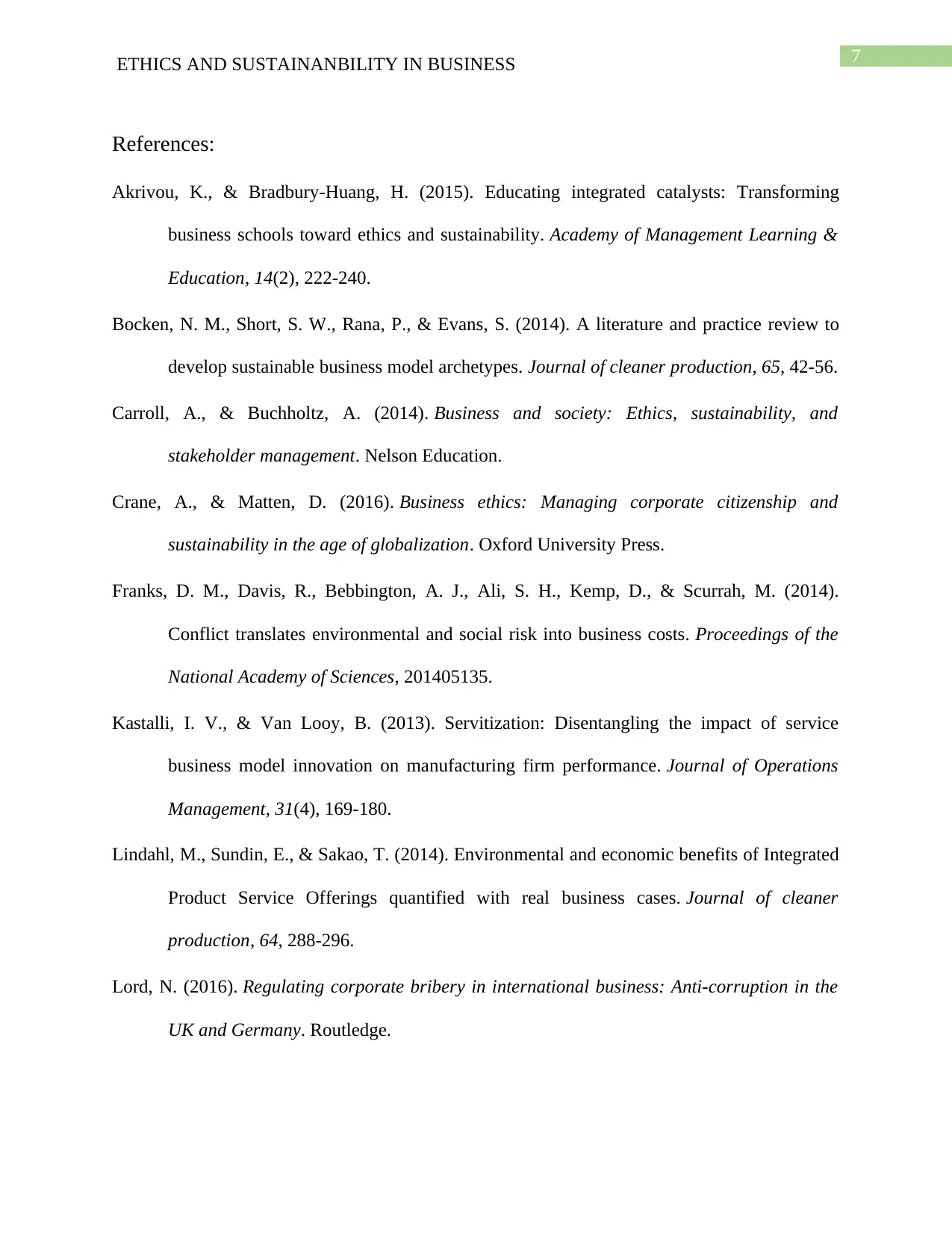
7ETHICS AND SUSTAINANBILITY IN BUSINESS
References:
Akrivou, K., & Bradbury-Huang, H. (2015). Educating integrated catalysts: Transforming
business schools toward ethics and sustainability. Academy of Management Learning &
Education, 14(2), 222-240.
Bocken, N. M., Short, S. W., Rana, P., & Evans, S. (2014). A literature and practice review to
develop sustainable business model archetypes. Journal of cleaner production, 65, 42-56.
Carroll, A., & Buchholtz, A. (2014). Business and society: Ethics, sustainability, and
stakeholder management. Nelson Education.
Crane, A., & Matten, D. (2016). Business ethics: Managing corporate citizenship and
sustainability in the age of globalization. Oxford University Press.
Franks, D. M., Davis, R., Bebbington, A. J., Ali, S. H., Kemp, D., & Scurrah, M. (2014).
Conflict translates environmental and social risk into business costs. Proceedings of the
National Academy of Sciences, 201405135.
Kastalli, I. V., & Van Looy, B. (2013). Servitization: Disentangling the impact of service
business model innovation on manufacturing firm performance. Journal of Operations
Management, 31(4), 169-180.
Lindahl, M., Sundin, E., & Sakao, T. (2014). Environmental and economic benefits of Integrated
Product Service Offerings quantified with real business cases. Journal of cleaner
production, 64, 288-296.
Lord, N. (2016). Regulating corporate bribery in international business: Anti-corruption in the
UK and Germany. Routledge.
References:
Akrivou, K., & Bradbury-Huang, H. (2015). Educating integrated catalysts: Transforming
business schools toward ethics and sustainability. Academy of Management Learning &
Education, 14(2), 222-240.
Bocken, N. M., Short, S. W., Rana, P., & Evans, S. (2014). A literature and practice review to
develop sustainable business model archetypes. Journal of cleaner production, 65, 42-56.
Carroll, A., & Buchholtz, A. (2014). Business and society: Ethics, sustainability, and
stakeholder management. Nelson Education.
Crane, A., & Matten, D. (2016). Business ethics: Managing corporate citizenship and
sustainability in the age of globalization. Oxford University Press.
Franks, D. M., Davis, R., Bebbington, A. J., Ali, S. H., Kemp, D., & Scurrah, M. (2014).
Conflict translates environmental and social risk into business costs. Proceedings of the
National Academy of Sciences, 201405135.
Kastalli, I. V., & Van Looy, B. (2013). Servitization: Disentangling the impact of service
business model innovation on manufacturing firm performance. Journal of Operations
Management, 31(4), 169-180.
Lindahl, M., Sundin, E., & Sakao, T. (2014). Environmental and economic benefits of Integrated
Product Service Offerings quantified with real business cases. Journal of cleaner
production, 64, 288-296.
Lord, N. (2016). Regulating corporate bribery in international business: Anti-corruption in the
UK and Germany. Routledge.
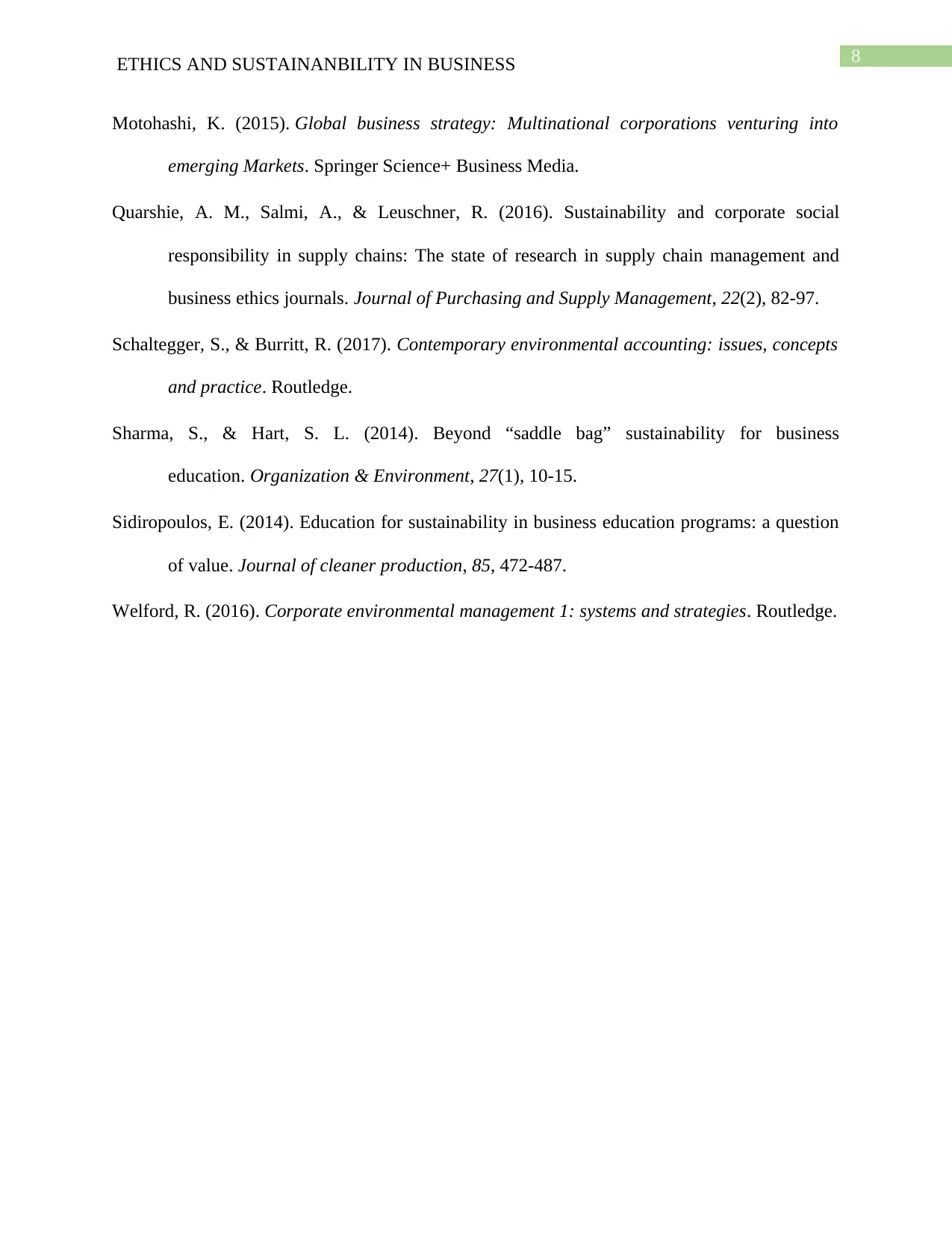
8ETHICS AND SUSTAINANBILITY IN BUSINESS
Motohashi, K. (2015). Global business strategy: Multinational corporations venturing into
emerging Markets. Springer Science+ Business Media.
Quarshie, A. M., Salmi, A., & Leuschner, R. (2016). Sustainability and corporate social
responsibility in supply chains: The state of research in supply chain management and
business ethics journals. Journal of Purchasing and Supply Management, 22(2), 82-97.
Schaltegger, S., & Burritt, R. (2017). Contemporary environmental accounting: issues, concepts
and practice. Routledge.
Sharma, S., & Hart, S. L. (2014). Beyond “saddle bag” sustainability for business
education. Organization & Environment, 27(1), 10-15.
Sidiropoulos, E. (2014). Education for sustainability in business education programs: a question
of value. Journal of cleaner production, 85, 472-487.
Welford, R. (2016). Corporate environmental management 1: systems and strategies. Routledge.
Motohashi, K. (2015). Global business strategy: Multinational corporations venturing into
emerging Markets. Springer Science+ Business Media.
Quarshie, A. M., Salmi, A., & Leuschner, R. (2016). Sustainability and corporate social
responsibility in supply chains: The state of research in supply chain management and
business ethics journals. Journal of Purchasing and Supply Management, 22(2), 82-97.
Schaltegger, S., & Burritt, R. (2017). Contemporary environmental accounting: issues, concepts
and practice. Routledge.
Sharma, S., & Hart, S. L. (2014). Beyond “saddle bag” sustainability for business
education. Organization & Environment, 27(1), 10-15.
Sidiropoulos, E. (2014). Education for sustainability in business education programs: a question
of value. Journal of cleaner production, 85, 472-487.
Welford, R. (2016). Corporate environmental management 1: systems and strategies. Routledge.
⊘ This is a preview!⊘
Do you want full access?
Subscribe today to unlock all pages.

Trusted by 1+ million students worldwide
1 out of 9
Related Documents
Your All-in-One AI-Powered Toolkit for Academic Success.
+13062052269
info@desklib.com
Available 24*7 on WhatsApp / Email
![[object Object]](/_next/static/media/star-bottom.7253800d.svg)
Unlock your academic potential
Copyright © 2020–2025 A2Z Services. All Rights Reserved. Developed and managed by ZUCOL.





